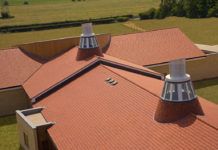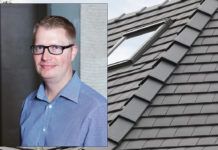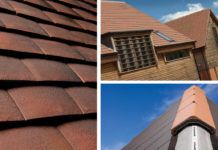
Sandtoft’s John Mercer shares some more of the many enquiries received via the Wienerberger Roofapedia website, together with the answers to these problems. He feels it is particularly important that roofing contractors understand the kind of concerns homeowners may have, and these are genuine questions and answers…
Question: We have water ingress on the chimneybreast and ceiling in our Scottish holiday home after recent storms. The house has a considerable amount of moss on the roof and the insurance inspector decided that this was the cause of the leaks and therefore not claimable under our insurance. I was just wondering if this was a common cause of water ingress and what the solution might be? I ask as we would be unable to prevent the moss from occurring due to the damp nature of the environment.
Answer: It is quite possible that the moss is partly to blame – heavy deposits can block tile and slate laps, interlocks and channels, causing water to run into the roof rather than being shed as intended. However, it would be advisable to have a local roofer check out the roof – it may be that the chimney flashings need repairing also.
With regard to removing the moss, ask your roofer about this also. The heavy deposits can normally be removed using a low pressure – not high pressure – wash of a proprietary toxic chemical; there are many available on the market. Some toxic washes leave a residue that discourages subsequent growth, but the residual effect is unlikely to last for more than two or three years. A more permanent solution is to install copper flashings and / or copper wires running across the roof. As the copper oxidizes, rainwater will wash copper salts down the roof slope from the copper that will discourage further moss growth.
Question: I had my roof pressure-washed to clean moss off and it looks like a small amount of the concrete tile surface layer has been removed. I have since looked into coating options but see there is a lot of bad press about them. Given that there may have been some slight degradation of the tiles due to the washing, the question is; is it better to leave them as they are, or should I get them coated?
Answer: Roof tile manufacturers do not recommend that tiles are pressure-washed because of the potential damage to the tile surface.
There have been several prosecutions of coatings companies based on the false claims they have made regarding benefits of their roof coatings. In some cases documented by Trading Standards, the cost of applying the coating was as high as the cost of installing a new tiled roof!
There is also a risk that old roof tiles will be damaged by the operatives walking on the roof as they apply the coating. It would be prudent to have the roof inspected by a roofing contractor. If your roof is sound and is not leaking, then you could paint the tiles, but bear in mind this would not really give any benefit other than cosmetic. If the roofer reports missing or slipped tiles and other faults such as cracked or missing flashings and mortar bedding etc., then you should consider installing a new roof.
Question: I recently had my old roof covering removed and replaced with new underlay, battens and concrete tiles. It has only been two and a half months since completion, but already I have a problem with mould on the rafters and everything is damp to the touch in the loft. I am pretty sure the membrane isn’t leaking, so is the problem condensation?
Answer: It sounds very much like condensation. Even though the underlay is most likely a vapour permeable type, a level of ventilation may be required, depending on the overall roof and ceiling design. I am guessing that the loft insulation thickness has been increased also? The standard way to ventilate a loft space is through continuous ventilators at the eaves; either soffit or over fascia vents, supplemented with high-level ventilation at the ridge; the most effective way is to install a dry ridge system. You need to talk to your roofing contractor to discuss the best way to achieve efficient roof ventilation. One easy option post roof installation (with proper access of course) may be to install some tile ventilators at low and high level.
Question: I have recently had my roof verges re-bedded and pointed. Unfortunately, numerous cracks appeared in the mortar on the same day the work was completed. The cracks run vertical from the tiles down to the fibreboard undercloak. The weather has been sunny so I assume this has caused the problem. Should the work be re-done?
Answer: Yes the work should be re-done. There should not be any cracks in the mortar pointing – this is most likely caused by the mortar drying out prematurely before it has had a chance to achieve its full set strength. It will need to be done again. If necessary, the tiles should be thoroughly wetted beforehand and if it is a hot day, it may be necessary to cover the wet pointing with wet sacking to ensure it sets properly.
Alternatively, a much better option would be have a dry verge system installed, rather than mortar bedding. A dry fix system would not be prone to any of the problems associated with mortar and would last much longer. I would suggest you seek advice as soon as possible.
Question: After being re-tiled my roof has a sagging appearance. Should I be concerned?
Answer: Yes, you should be concerned. The cause of the sagging may be due to the new roof covering being heavier than the previous one. You need to have a building surveyor inspect the roof as a matter of urgency.
There are considerable weight differences between types of roof coverings and so it is a Building Regulation requirement that an existing roof structure be inspected and, if necessary, strengthened, when a replacement roof covering is heavier than the previous roof.
Equally important, when a replacement roof covering is lighter than the previous one, the roof structure must be inspected and, if necessary, adequate anchorage to the building installed to maintain resistance to wind uplift.



